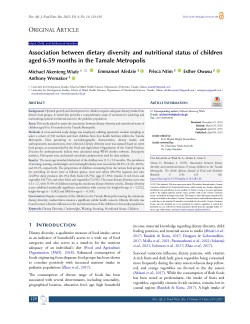Main Article Content
Association between dietary diversity and nutritional status of children aged 6-59 months in the Tamale Metropolis
Abstract
Background: Optimal growth and development in children requires adequate dietary intake from diverse food groups. A varied diet provides a comprehensive array of nutrients for achieving and maintaining optimal nutritional status in the pediatric population.
Aims: This study aimed to assess the association between dietary diversity and nutritional status of children aged 6 to 59 months in the Tamale Metropolis.
Methods: A cross-sectional study design was employed, utilizing systematic random sampling to select a cohort of 343 mothers and their children from four health facilities within the Tamale Metropolis. Data pertaining to sociodemographic characteristics, dietary intake, and anthropometric measurements, were collected. Dietary diversity score was assessed based on seven food groups, as recommended by the Food and Agriculture Organization of the United Nations. Z-scores for anthropometric indices were calculated using WHO Anthro software. Descriptive statistics, Chi-square tests, and partial correlation analyses were used for data analysis.
Results: The mean age (standard deviation) of the children was 11.9 ± 5.0 months. The prevalence of stunting, wasting, underweight, and overweight/obesity were recorded as 38.5%, 14.3%, 28.9%, and 18.1%, respectively. The proportions of children consuming from the various food groups in the preceding 24 hours were as follows: grains, roots and tubers (86.9%); legumes and nuts (24.8%); dairy products (46.1%); flesh foods (43.7%); eggs (17.8%); vitamin A rich fruits and vegetables (39.7%); and other fruits and vegetables (72.9%). The mean dietary diversity score was 3.3 ± 1.7, with 55.4% of children meeting the minimum dietary diversity criteria. Dietary diversity scores exhibited statistically significant correlations with z-scores for weight-for-age (r = 0.292), height-for-age (r = 0.382) and BMI-for-age (r = -0.165).
Conclusions: Despite a majority of the children in the Tamale Metropolis meeting the minimum dietary diversity, malnutrition remains a significant public health concern. Dietary diversity was found to exert a distinct influence on the nutritional status of the children in this study population.
Keywords: Dietary Diversity, Underweight, Wasting, Stunting, Nutritional Status, Children.







